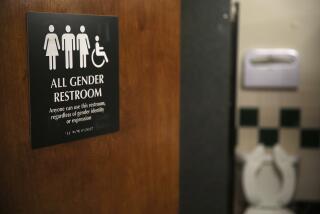It’s No Longer Just About Sex
- Share via
What ever happened to sex? I had to fill out a government form the other day and it asked for my gender, giving me two boxes to check, male or female. It wasn’t too many years ago that it would have asked for my sex, male or female.
When did the term “gender” replace “sex” to describe differentiation between males and females? And why? The term has become ubiquitous.
My old collegiate dictionary noted that sex is a distinction among living beings, as in the male and female sex, while gender is a distinction in some languages partially corresponding to the natural order, in which the names of objects are either of masculine, feminine, or neuter gender. As an English teacher said, “In English we don’t have gender, but only sex, which is much more interesting.”
Webster’s Unabridged advised that gender (from the Latin genus, meaning birth, race, kind or class) has an archaic use to signify kind or sort as in sex, but is primarily a linguistic term. The more recent American Heritage dictionary advised that, while gender has traditionally been used to refer to grammatical categories, the word has been used in recent years to refer to sexual identity or sex-based social or cultural categories.
The past two decades have produced a wide body of academic literature on gender, along with corresponding university and college departments, centers and courses focusing on the correlated issues of gender identity and gender studies. The textbooks for such courses all make the point that gender refers to the roles attached to biological sex; femininity and masculinity in this view are mere social constructs. As one correspondent puts it, “Sex refers to a biological statement of fact. Gender is the way one is socialized according to some standard of behavior associated with a role. Only women can bear children, but not only women can be mothers.”
It is now clear that when the government asked for my gender, there was something more involved than wanting to know my biological sex. There are only two sexes, but at least six if not eight genders: male, female, lesbian, homosexual or gay, bisexual of both sexes and transgendered of both sexes. The simple change from “sex” to “gender” on a form connotes a sea change in how we are coming to view our society and how it is being restructured.
More to Read
The biggest entertainment stories
Get our big stories about Hollywood, film, television, music, arts, culture and more right in your inbox as soon as they publish.
You may occasionally receive promotional content from the Los Angeles Times.








